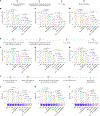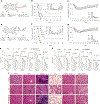Multimodal nanoimmunotherapy engages neutrophils to eliminate Staphylococcus aureus infections
- PMID: 38632494
- PMCID: PMC12126137
- DOI: 10.1038/s41565-024-01648-8
Multimodal nanoimmunotherapy engages neutrophils to eliminate Staphylococcus aureus infections
Abstract
The increasing prevalence of antimicrobial resistance in Staphylococcus aureus necessitates alternative therapeutic approaches. Neutrophils play a crucial role in the fight against S. aureus but suffer from deficiencies in function leading to increased infection. Here we report a nanoparticle-mediated immunotherapy aimed at potentiating neutrophils to eliminate S. aureus. The nanoparticles consist of naftifine, haemoglobin (Hb) and a red blood cell membrane coating. Naftifine disrupts staphyloxanthin biosynthesis, Hb reduces bacterial hydrogen sulfide levels and the red blood cell membrane modifies bacterial lipid composition. Collectively, the nanoparticles can sensitize S. aureus to host oxidant killing. Furthermore, in the infectious microenvironment, Hb triggers lipid peroxidation in S. aureus, promoting neutrophil chemotaxis. Oxygen supplied by Hb can also significantly enhance the bactericidal capability of the recruited neutrophils by restoring neutrophil respiratory burst via hypoxia relief. This multimodal nanoimmunotherapy demonstrates excellent therapeutic efficacy in treating antimicrobial-resistant S. aureus persisters, biofilms and S. aureus-induced infection in mice.
© 2024. The Author(s), under exclusive licence to Springer Nature Limited.
Conflict of interest statement
Competing interests
J.Z. and S.G. are inventors of a pending patent application filed by the Wisconsin Alumni Research Foundation. The other authors declare no competing interests.
Figures






References
-
- Antimicrobial Resistance and Primary Health Care (World Health Organization, 2018).
-
- Tacconelli E et al. Discovery, research, and development of new antibiotics: the WHO priority list of antibiotic-resistant bacteria and tuberculosis. Lancet Infect. Dis. 18, 318–327 (2018). - PubMed
-
- Lowy FD Staphylococcus aureus infections. N. Engl. J. Med. 339, 520–532 (1998). - PubMed
-
- Solomon SL & Oliver KB Antibiotic resistance threats in the United States: stepping back from the brink. Am. Fam. Physician 89, 938–941 (2014). - PubMed
-
- Daum RS Clinical practice. Skin and soft-tissue infections caused by methicillin-resistant Staphylococcus aureus. N. Engl. J. Med. 357, 380–390 (2007). - PubMed
MeSH terms
Substances
Grants and funding
- R01 AI177173/AI/NIAID NIH HHS/United States
- R21 AI156253/AI/NIAID NIH HHS/United States
- R01AI177173/Foundation for the National Institutes of Health (Foundation for the National Institutes of Health, Inc.)
- 1R21AI156253-01A1/Foundation for the National Institutes of Health (Foundation for the National Institutes of Health, Inc.)
LinkOut - more resources
Full Text Sources
Medical

